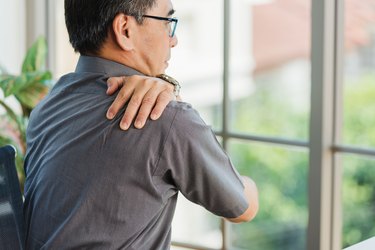
Disc herniation in the L5 to S1 area can occur when excessive loads are placed on your vertebrae. It commonly presents as lower back pain with or without pain that radiates down the back of one of your legs. Treatment is generally conservative at first, involving a short period of bed rest, pain killers and physical therapy. However, if your symptoms do not improve, your doctor may choose to do further tests to rule out more serious causes of lower back pain.
About Disc Herniation
Video of the Day
Intervertebral discs are structures found between vertebrae that help attach vertebrae to one another and provide a cushion to absorb loads placed on vertebrae by jumping, twisting and turning. According to orthopedic surgeons Craig Humphreys and Jason Eck, over time, as a result of stress or just from normal wear and tear, these discs can degenerate, and the inner portion of the disc, the annulus pulposis, can herniate into the region of your back occupied by the spinal cord. This causes pain and altered sensation in the regions of the body served by that portion of the cord. Disc herniations between the L5 and S1 vertebrae are one of the most common causes of low back pain.
Video of the Day
Treatment Options
According to Anthony Luke and C. Benjamin Ma in "Current Medical Disease and Treatment," the general first-line approach to treating a disc herniation involves up to two days of bed rest — longer has not been shown to help recovery — accompanied by non-steroidal anti-inflammatories, such as ibuprofen or naproxen, and physical therapy.
Exercises to Perform
Exercises for a herniated disc should focus on core stabilization, say Humphreys and Eck. The McKenzie back stretches are a specific set of movementsthat can help improve symptoms from disc herniation. These involve stretches that extend the back (for example, by standing up and leaning backwards) and flex the back (for example, by bending forward slowly as if you were going to touch your toes). Core stabilization is achieved by strengthening your abdominals and lower back muscles by doing sit-ups and weight-resistance training. Contacting a physical therapist is the best way to learn these exercises.
Exercises to Avoid
Although many people with low back pain due to disc herniation will return to full functioning with appropriate therapy, you should avoid certain exercises and activities while you are experiencing symptoms of herniation. According to back pain guidelines published by the University of Michigan, you should avoid exercises that put a lot of strain on your lower back, such as high-intensity weightlifting and contact activities such as football and ice hockey.
When Exercise Fails
As detailed in "Current Medical Diagnosis," if pain resulting from disc herniation persists for more than six weeks, if it is accompanied by progressive neurologic dysfunction (for example, progressively worsening pain that radiates down the back of your legs, or loss of bowel and bladder continence) or if it is accompanied by night sweats, weight loss or severe pain at rest, you should seek further care, as these are all "red flag" signs that something serious is going on in your back.
Is this an emergency? If you are experiencing serious medical symptoms, please see the National Library of Medicine’s list of signs you need emergency medical attention or call 911.